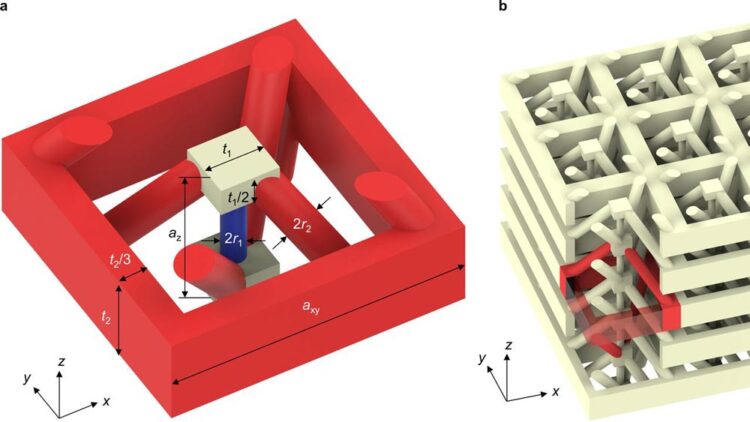Novel materials: Sound waves traveling backwards

Designed elastic metamaterial structure made of a single linear elastic material. (Illustration: Dr. Yi Chen, KIT)
Researchers of the 3D matter made to order cluster of excellence use rotons for metamaterials – Nature Communications publishes first results.
Acoustic waves in gases, liquids, and solids usually travel at an almost constant speed of sound. So-called rotons are an exception: their speed of sound changes significantly with the wavelength, and it is also possible that the waves travel backwards. Researchers at Karlsruhe Institute of Technology (KIT) are studying the possibilities of using rotons in artificial materials. These computer-designed metamaterials, produced by ultra-precise 3D laser printing, might be used in the future to manipulate or direct sound in ways that have never been possible before. A report on the researchers’ work has been published in Nature Communications. (DOI: 10.1038/s41467-021-23574-2)
Rotons are quasiparticles, which means that they behave similarly to free particles. Unlike ordinary acoustic waves in gases, liquids, and solids, the speed of sound changes significantly with the wavelength. In addition, certain frequencies generate three different partial waves. “The slowest among them is a backward wave: the energy flow and the wavefronts run in exactly opposite directions,” explains Professor Martin Wegener from the Institute of Applied Physics (APH) and KIT’s Institute of Nanotechnology (INT). Understanding and benefiting from quasiparticles such as rotons is one of the great challenges of quantum physics. Physicist Lev Landau, who won a Nobel Prize in 1962 for his groundbreaking work, predicted their existence in the context of superfluidity, a condition in which a fluid loses its internal friction and becomes thermally conductive in a nearly ideal way. Until now, rotons could only be observed under special quantum-physical conditions at very low temperatures – and were therefore not suitable to technical applications.
Rotons without Any Quantum Effects
This might change in the future: in the 3D Matter Made to Order Cluster of Excellence of KIT and the University of Heidelberg, a group of researchers is working on metamaterials that “grow” rotons. Metamaterials exhibit optical, acoustic, electrical, or magnetic properties that are not found in nature. The scientists propose an artificial material that can produce rotons without any quantum effects under normal ambient conditions and at almost random frequencies or wavelengths. Thus, it might be possible in the future to better manipulate sound waves in air or in materials, for example, to bounce them back, redirect them, or create echoes. These materials have not been demonstrated experimentally yet; however, it should be possible to produce them by using technologies such as ultra-precise 3D laser printing. “We have even made some of these metamaterials in the meantime,” Professor Martin Wegener says. “Currently, we are working intensively on the direct experimental proof for the existence of rotons.”
3D printing – the Gateway from the Digital to the Physical World
Dr. Yi Chen, lead author of the publication, explains that the researchers relied on a combination of reflection, many discussions and numerical simulations and optimizations to devise the computer-aided virtual design of materials with such novel properties. His work as a post-doctoral researcher at KIT is funded by the Alexander von Humboldt Foundation and is integrated into a Helmholtz program entitled “Material Systems Engineering” launched in 2021. “In general, our dream is to design materials on the computer and then turn them directly into reality – without years of trial and error. So 3D printing is just an automated converter, as it were, from the digital to the physical world,” Professor Martin Wegener explains.(or)
###
Original publication (Open Access):
Yi Chen, Muamer Kadic, and Martin Wegener: Roton-like acoustical dispersion relations in 3D metamaterials. Nature Communications, 2021. DOI: 10.1038/s41467-021-23574-2
Link to the paper: https:/
More information on the “3D Matter Made to Order” Cluster of Excellence: https:/
More about the KIT Materials Center: https:/
Contact for this press release:
Regina Link, Press Officer, Phone: +49 721 608-41158, regina.link@kit.edu
Being “The Research University in the Helmholtz Association”, KIT creates and imparts knowledge for the society and the environment. It is the objective to make significant contributions to the global challenges in the fields of energy, mobility, and information. For this, about 9,600 employees cooperate in a broad range of disciplines in natural sciences, engineering sciences, economics, and the humanities and social sciences. KIT prepares its 23,300 students for responsible tasks in society, industry, and science by offering research-based study programs. Innovation efforts at KIT build a bridge between important scientific findings and their application for the benefit of society, economic prosperity, and the preservation of our natural basis of life. KIT is one of the German universities of excellence.
All latest news from the category: Materials Sciences
Materials management deals with the research, development, manufacturing and processing of raw and industrial materials. Key aspects here are biological and medical issues, which play an increasingly important role in this field.
innovations-report offers in-depth articles related to the development and application of materials and the structure and properties of new materials.
Newest articles

First-of-its-kind study uses remote sensing to monitor plastic debris in rivers and lakes
Remote sensing creates a cost-effective solution to monitoring plastic pollution. A first-of-its-kind study from researchers at the University of Minnesota Twin Cities shows how remote sensing can help monitor and…

Laser-based artificial neuron mimics nerve cell functions at lightning speed
With a processing speed a billion times faster than nature, chip-based laser neuron could help advance AI tasks such as pattern recognition and sequence prediction. Researchers have developed a laser-based…

Optimising the processing of plastic waste
Just one look in the yellow bin reveals a colourful jumble of different types of plastic. However, the purer and more uniform plastic waste is, the easier it is to…



